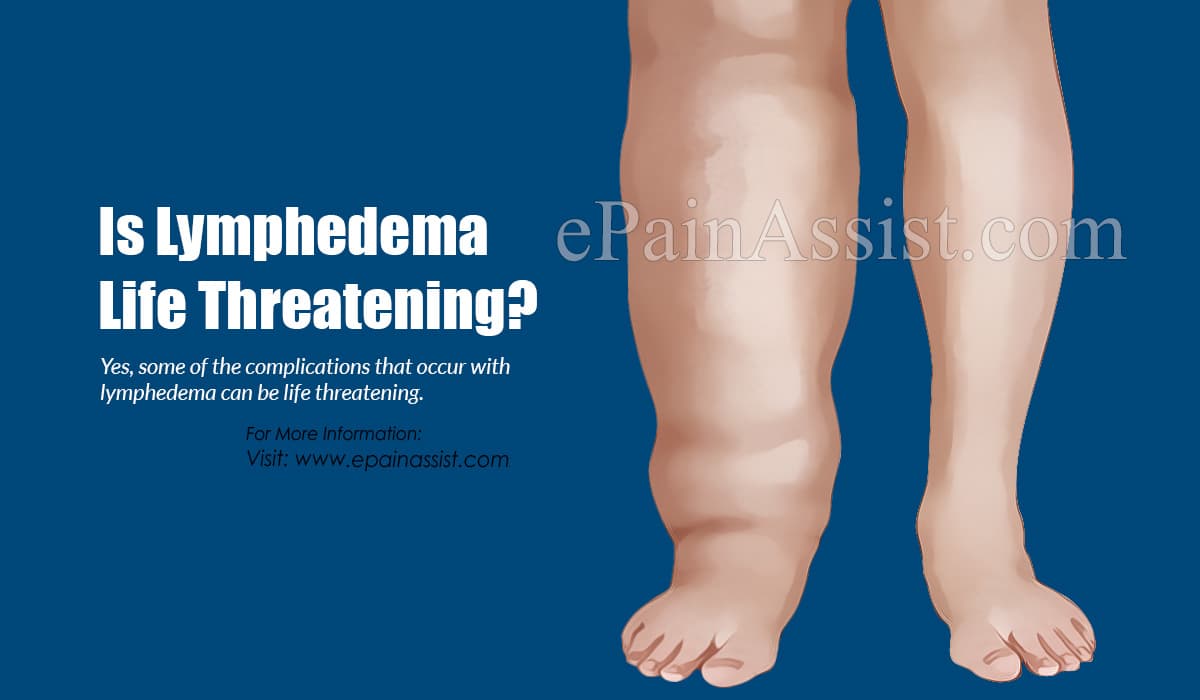Is Lymphedema Life Threatening?
Yes, some of the complications that occur with lymphedema can be life threatening. Let us see what are the complications of lymphedema, this will help you to understand the life threatening conditions that can occur with lymphedema.

Complications of Lymphedema In Your Arm or Leg
Cellulitis
Cellulitis is an acute inflammation of the skin and subcutaneous tissue, the risk of getting cellulitis is more if you have lymphedema because the skin stretches and thins out, as the lymph fluid get accumulate. This weakens the natural skin defense and increase the risk of getting infections. The folds that are created in the skin due to lymphedema can trap the bacteria. Once the bacteria enters the tissues lymph fluid is an ideal place to develop and grow in numbers. Cellulitis is caused usually by bacteria, commonly by Staphylococcus aureus or Group A streptococcus in a person with normal immunity. It can be caused by opportunistic organisms/normal flora in person with low immunity. If not treated adequately can infection can spread to the blood and cause septicemia.
Additional risk factors for cellulitis
- Breach in the skin caused by cuts, blisters, bites or burns
- Skin conditions like eczema, chicken pox
- Complication of liposuction, axial lymph node dissection,
- Overweight/obesity
- Immunocompromised
- Diabetes mellitus
Lymphangitis
Lymphangitis is an inflammation of the lymphatic vessels commonly due to a Group A Streptococcus infection associated with cellulitis, less commonly due to Staphylococcus aureus. These organisms enter the lymphatic system through a skin breach. The vessels that are inflamed appear as red streaks under the skin extending form the primary site to the groin or armpit. Other symptoms are fever, malaise, muscle aches, headache. If not treated early the infection can spread to the blood stream causing a potentially life threatening complication septicemia and eventually death.
Additional risk factors for lymphangitis
- Diabetes mellitus
- Immunocompromised patients
- Long term steroid users
Lymphangiosarcoma
Lymphangiosarcoma is a rare soft tissue cancer which occurs in patients with long standing primary or secondary lymphedema. This can occur in both extremities but commonly seen in the upper limb. Symptoms may include a red-blue or purple discoloration or skin nodule. People who suffer lymphedema for more than 10 years are at 10% risk of getting lymphangiosarcoma. Early diagnosis and treatment can give a better outcome, if not the tumor can spread to lungs and chest wall which can cause death (common cause of death). It also can spread to the liver and bone.
Additional risk factors for lymphangiosarcoma
- Recurrent infections
- Radiation
- Extensive fibrosis
- Middle aged or elderly women with a history of breast cancer
- Deep Vein Thrombosis
- DVT can cause pulmonary embolism and death.
Complications of Lymphedema In Your Head And Neck
Head and neck lymphedema can involve external structures like soft tissues of face and neck and internal structures like mucous membranes, respiratory and digestive tracts. This can give rise to serious complications such as breathing difficulties, swallowing difficulties which can give rise to nutritional deficiencies, speaking difficulties and dry mucous membranes.
Factors associated with head and neck lymphedema
- Tumor location
- Time duration since end of head and neck cancer treatment
- Radiation therapy dose
- Days of radiation
- Number of treatment modalities
Summary
There are several complications of lymphedema that can be life threatening. Cellulitis and lymphangitis can cause septicemia if the infection spreads to the blood it can even cause death. Lymphangiosarcoma is a rare tumor that occurs with long standing primary or secondary lymphedema. It commonly occurs in the upper limb and can spread to the lungs and chest wall and cause death. Deep vein thrombosis can cause pulmonary embolism and death. Lymphedema in the head and neck can cause breathing difficulties, swallowing difficulties, speaking difficulties, and dry mucous membranes. As you see lymphedema especially longstanding lymphedema can affect the quality of life and can be life threatening as well.
Also Read:
